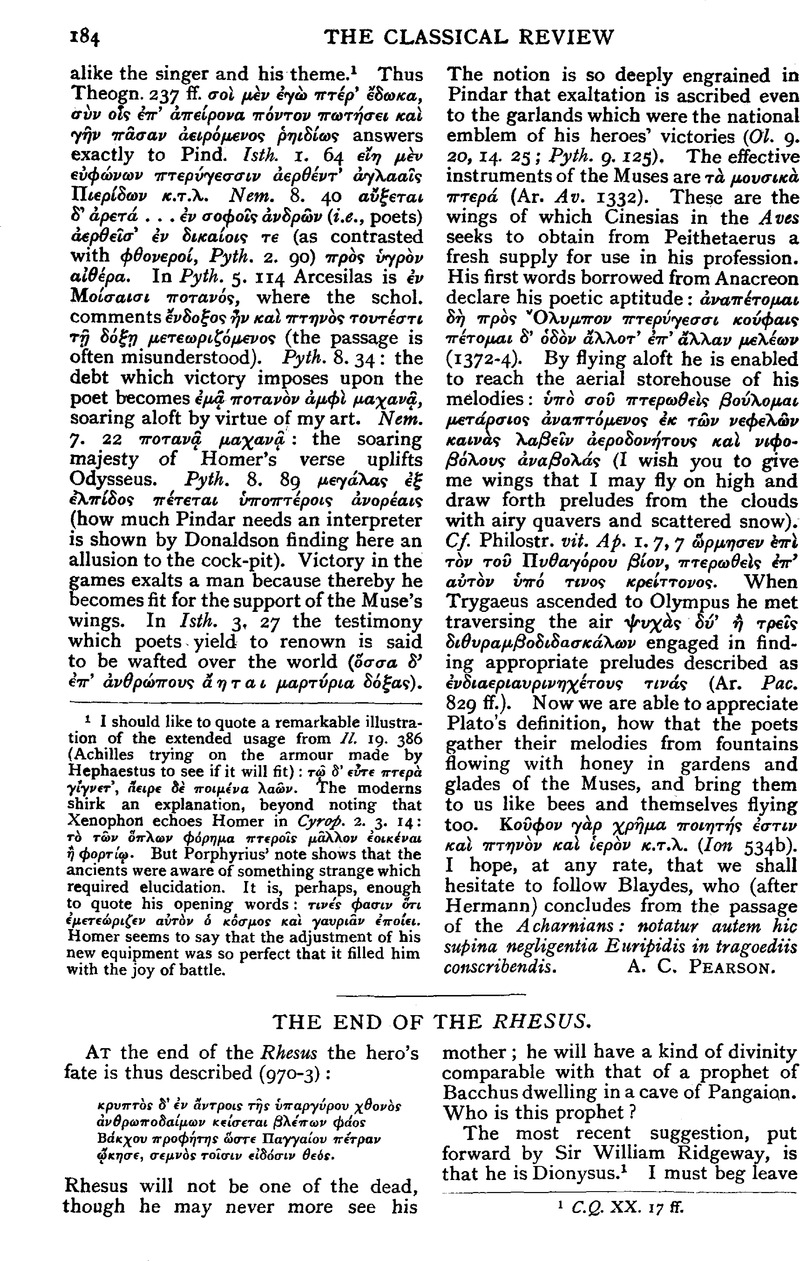
page 184 note 1 C.Q. XX. 17 ff.
page 185 note 1 We may note Pausan. VI. 26. 1, θεῷν δ⋯ ⋯ν τοῖς μ⋯λιστα δι⋯νυσον σ⋯βονσιν Ήλεῖοι.
page 185 note 2 Cf. A. S. F. Gow, J.H.S. XXXII. 213 ff.
page 185 note 3 The termination εῖος is vague. Explanations which have been offered are ‘god of the β⋯κχοι and β⋯κχοι (Preller - Robert, Griech. Myth. I.4 665), ‘god invoked with the cry ἰώ β⋯κχε’ (O. Jessen, P.W. II. 2789, 4), ‘god of Bacchic frenzy’ (Nilsson, , Griechische Feste, 301Google Scholar), and ‘god who is himself a Bacchant’ (Perdrizet, Cultes et Mythes du Pangée, 53, cf. Dionysos μ⋯στης). In any case β⋯κχος,βακχεῖος βακχε⋯ς, and the like are titles given to Dionysus qua god of orgiastic rites.
page 185 note 4 Strabo X. 3. 16, p. 471, τ⋯ν δι⋯ννσον δ⋯ κα⋯ τ⋯ν Ήδων⋯ν Λυκο⋯ργον συν⋯γοντες εἰς ἓν τ⋯ν ἔμ οιογρο⋯αν τῷν ἱερῷν αἰν⋯ττονται looks like Hellenistic theological speculation.
page 185 note 5 He is ἒνθεος (Kern, Orphica, 119, No. 49, 1.3), not θε⋯ς. The view that he was originally ‘the dark god’ remains a pure conjecture.
page 185 note 6 Aly, W., Volksmärchen, Sage und Novelle bei Herodot, 130Google Scholar, regards τ⋯ κατ⋯γαιον οἴκημα as Greek rationalisation of the common motif of the temporary disappearance of a wonderworker. Strabo, however, speaks of him as dwelling in a cave (p. 298), and it was, no doubt, the common Greek idea about him.
page 185 note 7 J. Weiss, P. W. VII. 1330. The difference of customs which Herodotus mentions (V. 3) refers, as he states in ch. 4, to Getic ⋯παθανατισμ⋯ς; he draws no distinction between their religious beliefs in general and those of the Thracians. In IV. 94–6 he repeatedly speaks of Zalmoxis as being among Thracians.
page 185 note 8 The story Strabo tells of the way in which the king of the Getae found his authority confirmed by the belief that he acted on divine monitions received by Zalmoxis looks like Greek theorising, similar to the view of Critias (Diels, Vorsokratiker, II.4 320 f., 81 B 25) that belief in the gods was invented to supply a sanction for law.
page 185 note 9 Jacoby, F., Fragmente d. griech. Hist. I., 125, n. 73Google Scholar. Müller, Fragm. hist, graec. I. 69 n. 173 (Müller regarded this as pseudo-Hellanicus).
page 186 note 1 VII. III: The localisation is made by Hiller von Gärtringen, De graecorum fabulis ad Thraces pertinentibus, 81, E. Maass, Perdrizet, and Ridgeway. This shrine must be distinguished from that in Crestonia, which lay more to the West.
page 186 note 2 Βησσο⋯ δ⋯ τῷν σατρ⋯ων ε⋯σι οἱ προφητε⋯οντες το⋯ ἱρο⋯. The analogies of Delphi, the Ptoion, Didyma, and the oracle of Apollon Koropaios at Demetrias would support the view that one prophet is implied; but Apollo had propheiai at Argos (B.C.H. XXVII. 274) and 6 ⋯ προφ⋯της may always mean ‘the prophet on duty’ (P. Monceaux, Dar.-Sagl. IV. 218).
page 186 note 2 Cf. C. T. Seltman, Athens, its History and Coinage, 54 ff. The writer is indebted to Professor H. J. Rose for valuable criticisms of an earlier draft of this paper.